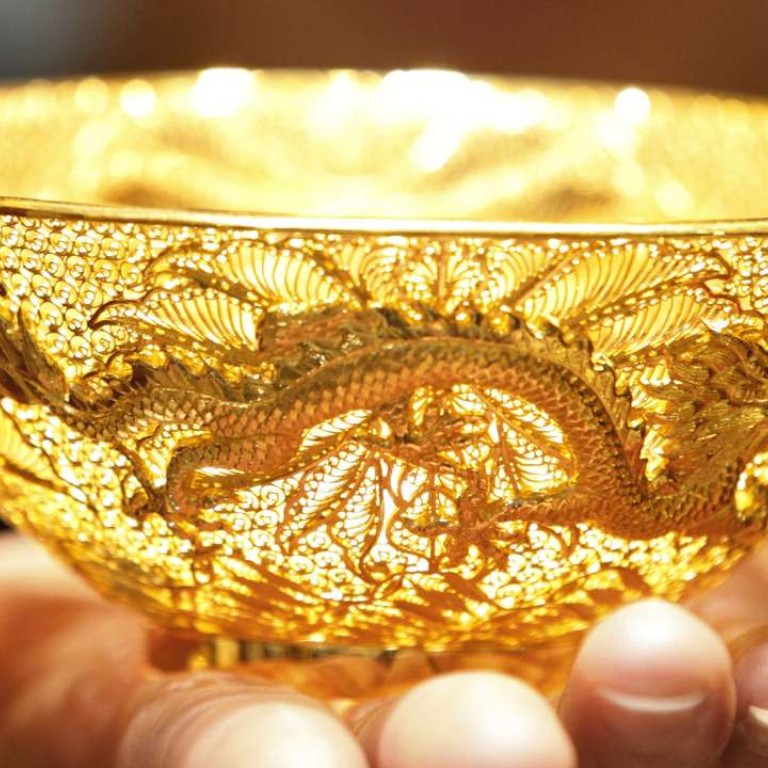
Gold price rally still to peak, as global economic worries continue
Demand rises 15pc in second quarter, after price soars 26pc from a six-year low of US$1,060.2 per ounce at the start of the year
The current rise in the price of gold is yet to peak, according to analysts, after jumping 26 per cent in the first half.
The spot gold price surged from a six-year low of US$1,060.2 per ounce at the start of the year to US$1,320.6 by June 30, amid fears over Brexit, delays in interest rate rises in the United States and rate cuts by global central banks, amid the ongoing global economic slowdown.
The price has been swinging between US$1,320 and US$1,360 over the past couple of months, compared with its historic high of US$1,900 in August 2011.
“We are quite optimistic on the gold price over the next six months and the coming year.
“[Gold] is just waiting for the next catalyst or piece of bad economic data to come out,” said Robin Tsui, vice president and gold exchange traded funds (EFTs) specialist at State Street Global Advisor (SSGA).
Tsui now expects the yellow metal to reach US$1,400 to US$1,450 by the end of this year, as most of the uncertainties in the first half, the catalyst for the safe-haven gold, still remain unresolved.
There could be some indication on US interest rates at the end of the week from Fed chairman Janet Yellen.
But the current negative-yield environment lowers the cost of holding gold and the UK continues to put pressure on economic growth after the Brexit vote, both of which could increase the gold price further.
“UK interest rates have been cut to 0.25 per cent, but they could be slashed further to zero per cent...the gold price is really driven by fundamentals,” Tsui said.
The US presidential election in November is another unpredictable factor, and a win by Donald Trump might add more worries, pushing the price higher, Tsui added.
In the first half, net inflow to SPDR Gold Trust shares, the world’s biggest physically backed gold EFT, reached US$12 billion, representing a record six-month inflow since the product was listed in 2004.
The annual inflow this year is also likely to break its US$11 billion record in 2009, as net inflow continued in July and August, although the pace has slowed and there was a net outflow in the second week of August, Tsui said.
The forecast for gold remains positive, with the metal expected to be trading in the range of US$1,300-US$1,400 at the end of the year
Some investors have taken profits at the current levels, while others have shifted money into equity markets in Hong Kong or the United States.
“Redemption and trading are so easy for ETFs....However, what we’ve been seeing is that US equities are at historic highs while the gold price is still hovering at the same level.
“Once the stock market corrects a little, we will see gold jump,” Tsui said.
Most SPDR and gold ETF buyers were strategic institutional investors, the biggest of whom was SSGA’s competitor BlackRock, the world’s largest fund manager that owns the iShares Gold Trust, which ploughed US$3-4 billion into the SPDR Gold shares in the first half.
“We were surprised, but I guess they have a quota on how much they can buy their own ETFs,” Tsui said.
Fund managers tend to see gold as “portfolio insurance”, Tsui said.
With equities at a record high and bonds delivering negative yields, fund managers are likely to be eyeing the metal to hedge against potential downfalls in other assets, he said, suggesting investors could be allocating as much as 10 per cent of their portfolios to gold.

The latest report from the World Gold Council showed that demand in the second quarter surged 15 per cent year on year to 1,050.2 tonnes, as investment demand soared 141 per cent up to 448.4 tonnes.
Gold-related ETFs saw the most dramatic rise, with its appeal expanding across western borders to China.
Chinese investors increased their domestic Gold ETFs holdings by US$1 billion by the end of June, almost a fourfold increase from the start of the year, according to the report.
Kenny Fisher, currency analyst at Oanda, wrote in a note: “Gold may be hard-pressed to repeat [the first half’s] feat in the next six months, but the forecast for gold remains positive, with the metal expected to be trading in the range of US$1,300-US$1,400 at the end of the year.”
US indicators, especially gross domestic product, non-farm payrolls and consumer price indexes can have a strong impact on the movement of gold.
If they show strong improvement, gold prices could soften, according to Fisher.
The year has seen no shortage of potential clashes in the geopolitical arena, which also play an important role in gold price movements.
However, such events often add volatility to gold which offers opportunities to traders rather than having a lasting effect on the metal’s price, Fisher said.

